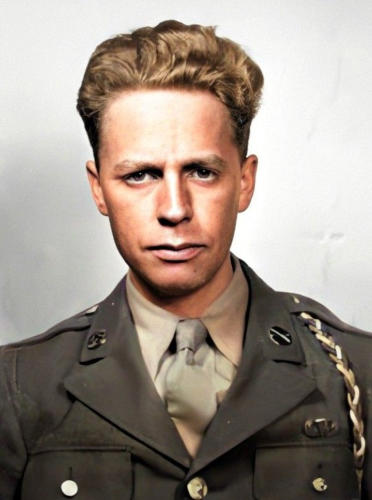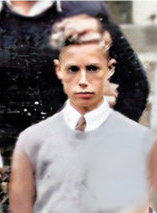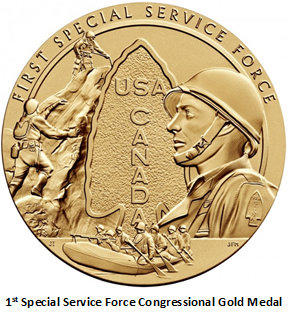
copyright © Wartime Heritage Association
Website hosting courtesy of Register.com - a web.com company
Wartime Heritage
ASSOCIATION

Remembering World War II
Theodore Michael McDonald


Sources:
American Battle Monuments Commission – Theodore Michael McDonald
American Battle Monuments Commission – Rhone American Cemetery
Findagrave
Name:
Theodore Michael McDonald
Rank:
Private
Service Number:
(36201028), 36246219
Service:
1st Special Service Force, US Army
Awards:
Bronze Star,
Purple Heart with 2 Oak Leaf Clusters
Date of Birth:
March 24, 1916
Place of Birth:
Ingonish, Victoria Co., Cape Breton, NS
Date of Enlistment:
September 27, 1941
Place of Enlistment:
Scott Field, Illinois
Age at Enlistment:
26
Address at Enlistment:
La Crosse, Wisconsin
Occupation:
Actor, Carpenter’s apprentice
Height:
5 feet, 7 ½ inches
Complexion:
Light
Hair Color:
Blond
Eye Color:
Blue
Date of Death:
September 9, 1944
Age:
28
Cemetery:
Rhone American Cemetery, Draguignan, France
Grave:
Tablets of the Missing
Theodore Michael McDonald was the son of John James McDonald (1881-1956) and Rosalie ‘Rose’
(Karpinski) McDonald (1889–1980). His mother was of born in Wisconsin; his father in Ingonish, NS.
Theodore had three sisters, Virginia Elizabeth (1912-2002), Vivian Rose (1914-1986), and Pauline Eleanor
(1919-1994).
Theodore’s entire family moved to the US in 1920, his mother and the four children crossing at Detroit,
Michigan on November 24, 1920, and settled in Wisconsin.
Theodore attended La Crosse Central High School in La Crosse, WI. He registered
for the US Draft October 16, 1940, in Madison, WI. He was a student at the
University of Wisconsin at the time and completed two-three years of civil
engineering.
Upon initial enlistment with the USAAF as an Air Cadet, William trained at Scott
Field, Illinois, and Harvey airport, Missouri. After an accident at the latter, he
was discharged from the air force and returned home.
He re-enlisted June 17, 1942, in Milwaukee, Wisconsin and transferred to Fort
William Henry Harrison in Helena, Montana for basic training. He volunteered
for the paratroops and was sent to Camp Ethan Allen, Virginia, and later
entered commando training at Norfolk, VA. He served in Alaska with Canadian
and American paratroops of the FSSF in Operation Cottage during the Kiska Campaign in the Aleutian
Islands, and returned home on furlough in September of 1943, leaving in October to go overseas.
Private McDonald was wounded twice in Europe, first in the leg and shoulder on December 4, 1943 while
serving in North Africa and the second time on May 29, 1944 in Italy, when shrapnel struck him in the chest.
He was awarded the purple heart in January 1944.
On September 7, 1944, the First Special Service Force moved to defensive positions on the Franco-Italian
border with the 1st Airborne Task Force. Theodore was
reported Missing in Action and presumed dead September 9,
1944. Little is known about the circumstances of his death.
Private Theodore Michael McDonald is commemorated at the
Rhone American Cemetery. He is listed with nearly 300
names, those who’s bodies were never found, inscribed on
the terrace wall outside the memorial. On the face of the
Memorial, an angel peace watches over the graves, and olive
trees among the headstones add to the tranquility of this
peaceful place with secluded gardens providing space for
quiet contemplation.
The First Special Service Force was awarded the
Congressional Gold Medal in 2015. The Congressional Gold
Medal is the highest civilian honor awarded by the US
Congress.


Theodore school Photo 1933

La Crosse Tribune, Saturday, October 4, 1944:
Mr. and Mrs. J. J. McDonald, 1701 ½ Adams Street, [La Crosse, Wisconsin] formerly of 2202 South
16th Street, received word Saturday morning that their son, Sgt. Theodore Michael McDonald, has
been reported missing in action since Sept. 9 in France. The communication was from J. A. Ulio,
adjutant general.
Sgt. McDonald was wounded twice, first in the leg and shoulder Dec. 4, 1943, while serving in North
Africa and the second time May 29 of this year in Italy, when shrapnel struck him in the chest. He was
awarded the purple heart in January, 1944.
McDonald, a Central graduate, enlisted in the army in January of 1941 after having studied civil
engineering for three years at the University of Wisconsin. He received his training at Scott Field, Ill.,
and Harvey airport, Mo. After an accident at the latter place, he was discharged from the air force
and returned home.
Re-entering two months later he went to Helena, Mont., for basic training, volunteered for the
paratroops and was sent to Camp Ethan Allen, Va., and later entered commando training at Norfolk,
Va. He served in Alaska with Canadian and American paratroops and came home on furlough in
September of 1943, leaving in October to go overseas.


- World War I - Menu
- WWI Stories and Articles
- Photos - Yarmouth Soldiers
- Selection of World War I Songs
- WWI Casualties of Yarmouth, NS
- Those Who Served - Yarmouth, NS
- WWI Casualties Digby Co. NS
- WWI Casualties Shelburne Co. NS
- Merchant Mariners (1915) Yarmouth, NS
- Canadian Forestry Corps - Non Yarmouth Birth/Residence Enlistments
- US Draft Registry - Yarmouth NS Born


- World War II - Menu
- WWII Stories and Articles
- Telegraphist Air Gunners
- WWII Casualties of Nova Scotia
- US Casualties with NS Connection
- Far East/Pacific Casualties with NS Connection
- Merchant Navy Casualties Nova Scotia
- Nova Scotia WWII Casualties Holten Canadian War Cemetery
- D-Day Casualties - Nova Scotia
- CANLOAN Program Casualties - Nova Scotia
- Battle of the Bulge Casualties - Nova Scotia
- WWII Casualties Yarmouth NS
- Yarmouth Casualties - RCAF RAF Canadian Army WWII
- Yarmouth Co., Marriages WWII
- Casualties Non-Born/Residents with Connection to Yarmouth Co., Nova Scotia.
- WWII Casualties Digby Co., NS
- Non-Nova Scotian WWII Casualties Buried in Nova Scotia
- WWII RCAF Casualties Aged 16-18
- Brothers/Sisters Who Served - World War II













